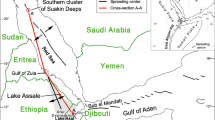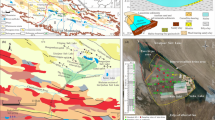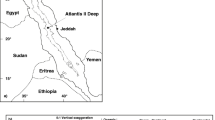Abstract
Halite brine (saturation ranging from 45 to 80%) lies within glacial sediments that fill the Onondaga Trough, a bedrock valley deepened by Pleistocene glaciation near Syracuse, New York State, USA. The most concentrated brine occupies the northern end of the trough, about 10 km downgradient of the northern limit of halite beds in the Silurian Salina Group, the assumed source of salt. The chemical composition of the brine and its radiocarbon age suggest that the brine originally formed about 16,700 years ago through dissolution of halite by glacial melt water and later mixed with saline bedrock water. Two hypotheses regarding the formation of the brine pool were tested through variable-density flow simulations using SEAWAT. Simulation results supported the first hypothesis that the brine pool was derived from a source in the glacial sediments and then migrated to its current position, where it has persisted for over 16,000 years. A second hypothesis that the brine pool formed through steady accumulation of brine from upward flow of a source in the underlying bedrock was not supported by simulation results, because the simulated age distribution was much younger than the age estimated from geochemical modeling.
Résumé
Des saumures riches en halite (saturation comprise entre 45 et 80%) se situent dans les sédiments glaciaires qui remplissent le Bassin d’Onondaga Trough, vallée rocheuse approfondie par la glaciation pléistocène à proximité de Syracuse (Etat de New York, Etats-Unis). Les saumures les plus concentrées occupent l’extrémité nord du bassin, à environ 10 km à l’aval hydraulique de la limite nord des lits de halite du Silurian Salina Group, la source supposée du sel. La composition chimique de la saumure et son âge radiocarbone suggère qu’elle s’est initialement constituée il y a environ 16700 ans, par dissolution de la halite par l’eau de fonte glaciaire, et s’est ensuite mélangée avec l’eau de la roche-mère saline. Deux hypothèses sur la formation d’une ressource sursalée ont été testées par simulation d’écoulements à densités variables, sous SEAWAT. Les résultats de la simulation confirment la première hypothèse : la ressource sursalée prend son origine dans les sédiments glaciaires et a migré vers la position actuelle, où elle se maintient depuis plus de 16000 ans. La seconde hypothèse était que la ressource sursalée s’était formé par accumulation de saumure sous un flux ascendant issu de la roche-mère sous-jacente; elle n’a pas été validée par les résultats de la simulation, parce que les âges simulés apparaissaient bien inférieurs aux âges estimés à partir des modélisations géochimiques.
Resumen
Una salmuera de halita (con una saturación que oscila entre el 45 y el 80%) se encuentra en sedimentos glaciares que rellenan el Onondaga Trough, un valle rocoso excavado por la glaciación Pleistocena cerca de Siracusa, en el estado de Nueva York, USA. La salmuera más concentrada ocupa el extremo norte del valle, a 10 km aproximadamente aguas abajo del límite norte de los estratos de halita en el Grupo Silúrico Salina, la supuesta fuente de sal. La composición química de la salmuera y su edad medida por radiocarbono sugiere que se formó originalmente hace aproximadamente 16,700 años a partir de la disolución de halita por el deshielo de agua glacial y su posterior mezcla con agua de los cuerpos salinos. Se han considerado dos hipótesis observando la formación de la salina mediante simulaciones de flujo de densidad variable usando SEAWAT. Los resultados de la simulación confirmaron la primera hipótesis, consistente en que la salina derivó de una fuente en los sedimentos glaciares y entonces migró hasta su posición actual, donde ha permanecido durante más de 16,000 años. Una segunda hipótesis consistente en la salina se formó mediante la acumulación estacionaria de salmuera desde un flujo aguas arriba de una fuente en el estrato inferior no se vio confirmada por los resultados de la simulación, porque la distribución de edad simulada fue mucho más joven que la edad estimada de la modelación geoquímica.














Similar content being viewed by others
References
Anderson NL, Hinds RC (1997) Glacial loading and unloading: a possible cause of rock salt dissolution in the Western Canada Basin. Carbon Evapor 12:43–52
Bense VF, Person MA (2006) Faults as conduit-barrier systems to fluid flow in siliciclastic sedimentary aquifers. Water Resour Res 42(5), W05421. DOI 10.1029/2005WR004480
Boulton GS, Caban PE, van Gijssel K (1995) Groundwater flow beneath ice sheets: part I-large scale patterns. Quat Sci Rev 114:545–562
Brasier FM, Kobelski BJ (1996) Injection of industrial wastes in the United States. In: Apps JA, Tsang CF (eds) Deep injection disposal of hazardous and industrial waste. Academic Press, San Diego, CA, pp 1–8
Bredehoeft JD, Blyth CR, White WA, Maxey GB (1963) Possible mechanism for concentration of brines in subsurface formations. Am Assoc Petrol Geol Bull 47:257–269
Burnett AW, Mullins HT, Patterson WP (2004) Relationship between atmospheric circulation and winter precipitation δ18O in central New York State. Geophys Res Lett 31:L22209
Carpenter AB (1978) Origin and chemical evolution of brines in sedimentary basins. Oklahoma Geol Surv Circ 79:60–77
Chebotarev II (1955) Metamorphism of natural waters in the crust of weathering. Geochim Cosmochim Acta 8:137–170
Clark ID, Fritz P (1997) Environmental isotopes in hydrogeology. Lewis, Boca Raton, FL, USA
Dausman A, Langevin CD (2005) Movement of the saltwater interface in the surficial aquifer system in response to hydrologic stresses and water-management practices, Broward County, Florida. US Geol Surv Sci Invest Rep 2004–5256
Deines P, Langmuir D, Harmon RS (1974) Stable carbon isotope ratios and the existence of a gas phase in the evolution of carbonate ground waters. Geochim Cosmochim Acta 38:1147–1164
Dutton AR (1989) Hydrogeochemical processes involved in salt-dissolution zones, Texas Panhandle, USA. Hydrol Process 3:75–89
Effler SW (ed) (1996) Limnological and engineering analysis of a polluted urban lake. Springer, New York
Effler SW, Perkins MG (1987) Failure of spring turnover to occur in Onondaga Lake, NY, USA. Water Air Soil Poll 34:285–291
Effler SW, Doerr SM, Brooks CM, Rowell HC (1990) Chloride in the pore water and water column of Onondaga Lake, NY, USA. Water Air Soil Poll 51:315–326
Frape SK, Blyth A, Blomqvist R, McNutt RH, Gascoyne M (2004) Deep fluids in the continents II: crystaline rocks. In: Drever JI (ed) Surface and ground water, weathering and soils, treatise on geochemistry, vol 5, chapter 17. Elsevier, New York, pp 541–580
Gingerich SB, Voss CI (2005) Three-dimensional variable-density flow simulation of a coastal aquifer in southern Oahu, Hawaii, USA. Hydrogeol J 13:436–450
Graf DL, Meents WF, Friedman I, Shimp NF (1966) Origin of saline formation waters, III: calcium chloride waters. Illinois Geol Surv Circ 397
Grasby SE, Chen Z (2005) Subglacial recharge into the Western Canada Sedimentary Basin: impact of Pleistocene glaciation on basin hydrodynamics. Geol Soc Am Bull 117:500–514
Guo W, Langevin CD (2002) Users guide to SEAWAT: a computer program for simulation of three-dimensional variable-density ground-water flow. US Geological Survey Techniques of Water-Resources Investigations, book 6, chapter A7, US Geological Survey, Reston, VA
Hand BM (1978) Syracuse melt-water channels. In: New York State Geol Assoc Guidebook, 50th Annual Meeting, 23–24 September 1978, Syracuse University, NY, USA, pp 286–314
Hanor JS (1983) Fifty years of development of thought on the origin and evolution of subsurface sedimentary brines. In: Boardman SJ (ed) Evolution and the earth sciences advances in the past half-century. Kendall/Hunt, Dubuque, IW, USA, pp 99–111
Hanor JS (1987) History of thought on the origin of subsurface sedimentary brines. In: The history of hydrology: history of geophysics, vol 3. Am Geophys Union, Washington, DC, pp 81–91
Harbaugh AW, Banta ER, Hill MC, McDonald MG (2000) MODFLOW-2000, the U.S. Geological Survey modular ground-water model-User guide to modularization concepts and the ground-water flow process. US Geol Surv Open-File Rep 00–92
Herzog HJ, Drake EM (1998) CO2 capture, reuse, and sequestration technologies for mitigating global climate change. In: Proceedings of the 23rd International Technology Conference on Coal Utilization and Fuel Systems. Clearwater, FL, March 1998, pp 615–626
Horita J, Wesolowski D, Cole D (1993) The activity-composition relationship of oxygen and hydrogen isotopes in aqueous salt solutions: I. vapor-liquid water equilibration of single salt solutions from 50 to 100°C. Geochim Cosmochim Acta 57:2797–2817
Johannsen K, Kinzelbach W, Oswald S, Wittum G (2002) The saltpool benchmark problem-numerical simulation of saltwater upconing in a porous medium. Adv Water Resour 25:335–348
Johnson KS (1981) Dissolution of salt on the east flank of the Permian Basin in the southwestern USA. J Hydrol 54:75–93
Jones BF, Anderholm SK (1996) Some geochemical considerations of brines associated with bedded salt repositories. In: Bottrel SH (ed) Fourth International Symposium on the Geochemistry of the Earth’s Surface, Ilkley, Yorkshire, July 1996, International Assoc. of Geochemistry and Cosmochemistry, Pinawa, MB, Canada, pp 343–353
Kappel WM (2000) Salt production in Syracuse, New York (“The Salt City”) and the hydrogeology of the Onondaga Creek Valley. US Geological Survey Fact Sheet FS 139–00, US Geological Survey, Reston, VA
Kappel WM, Miller TS (2003) Hydrogeology of the Tully Trough, southern Onondaga County and northern Cortland County, New York. US Geol Surv Water-Resour Invest Rep 03–4112
Kappel WM, Miller TS (2005) Hydrogeology of the valley-fill aquifer in the Onondaga Trough, Onondaga County, New York. US Geol Surv Sci Invest Rep 2005–5007
Kappel WM, Sherwood DA, Johnston WH (1996) Hydrogeology of the Tully Valley and characterization of mudboil activity, Onondaga County, New York. US Geol Surv Sci Invest Rep 96–4043
Kharaka YK, Hanor JS (2004) Deep fluids in continents: I. sedimentary basins. In: Drever JI (ed) Surface and ground water, weathering and soils, treatise on geochemistry. vol 5, chapter 16, Elsevier, New York, pp 499–540
Kurlansky M (2002) Salt: a world history. Penguin, New York
Lahm TD, Bair ES (2000) Regional depressurization and its impact on the sustainability of freshwater resources in an extensive mid-continent variable-density aquifer. Water Resour Res 36:3167–3178
Lahm TD, Bair ES, VanderKwaak J (1998) Role of salinity-derived variable-density flow in the displacement of brine from a shallow, regionally extensive aquifer. Water Resour Res 34:1469–1480
Lambert SJ (1978) Geochemistry of Delaware Basin ground waters. In: Austin GS (ed) Geology and mineral deposits of Ochoan rocks in Delaware Basin and adjacent areas. New Mexico Bur Mines Min Resour Circ 159:33–38
Langevin CD, Guo W (2006) MODFLOW/MT3DMS-based simulation of variable-density ground water flow and transport. Ground Water 44:339–351
Langevin CD, Shoemaker WB, Guo W (2003) MODFLOW-2000, the U.S. Geological Survey modular ground-water model-Documentation of the SEAWAT-2000 version with the variable-density flow process (VDF) and the integrated MT3DMS transport process (IMT). US Geol Surv Open-File Rep 03–426
Mason JL, Kipp KL (1997) Hydrology of the Bonneville Salt Flats, northwestern Utah, and the simulation of ground-water flow and solute transport in the shallow-brine aquifer. US Geol Surv Prof Pap 1585, US Geological Survey, Reston, VA
McIntosh JC, Walter LM (2006) Paleowaters in Silurian-Devonian carbonate aquifers: geochemical evolution of groundwater in the Great Lakes region since the Late Pleistocene. Geochim Cosmochim Acta 70:2454–2479
Mullins HT, Hinchey EJ, Wellner RW, Stephens DB, Anderson WT, Dwyer TR, Hine AC (1996) Seismic stratigraphy of the Finger Lakes: a continental record of Heinrich event H-1 and Laurentide ice sheet instability. Geol Soc Am Spec Pap 311
New York State Department of Environmental Conservation (NYSDEC) (1988) Generic environmental impact statement on the oil, gas and solution mining regulatory program, vol II, NYSDEC, Albany, NY, USA
Novak SA, Eckstein Y (1988) Hydrochemical characterization of brines and identification of brine contamination in aquifers. Ground Water 26:317–324
Oi T, Nomura M, Musashi M, Ossaka T, Okamoto M, Kakihana H (1989) Boron isotopic compositions of some boron minerals. Geochim Cosmochim Acta 53:3189–3197
Onondaga County Department of Water Environment Protection (2002) Onondaga Lake ambient monitoring program executive summary, 2002. Onondaga County Department of Water Environment Protection, Syracuse, NY, USA
Ophori DU (1998) Flow of groundwater with variable density and viscosity, Atikokan Research Area, Canada. Hydrogeol J 6:193–203
Oswald SE, Kinzelbach W (2004) Three-dimensional physical benchmark experiments to test variable-density flow models. J Hydrol 290:22–42
Phalen WC (1919) Salt resources of the United States. US Geol Surv Bull 669, US Geological Survey, Reston, VA
Plummer LN, Prestemon EC, Parkhurst DL (1994) An interactive code (NETPATH) for modeling NET geochemical reactions along a flow PATH Version 2.0. US Geol Surv Water Resour Invest Rep 94–4169
Poeter EP, Hill MC (1998) Documentation of UCODE, a computer code for universal inverse modeling. US Geol Surv Sci Invest Rep 98–4080, p 116
Pohlmann KF, Hassan AE, Chapman JB (2002) Modeling density-driven flow and radionuclide transport at an underground nuclear test: uncertainty analysis and effect of parameter correlation. Water Resour Res 38:1059–1076
Pollock DW (1994) User’s guide for MODPATH/MODPATH-PLOT, version 3: a particle tracking post-processing package for MODFLOW, the US Geological Survey finite-difference ground-ware flow model. US Geol Surv Open-File Rep 94–464
Ranganathan V, Hanor JS (1988) Density-driven groundwater flow near salt domes. Chem Geol 74:173–188
Rickard LV (1969) Stratigraphy of the upper Silurian Salina Group New York, Pennsylvania, Ohio, Ontario. Map and Chart Series No. 12. New York State Museum and Science Service, Albany, New York
Spivack AJ, Palmer MR, Edmond JM (1987) The sedimentary cycle of the boron isotopes. Geochim Cosmochim Acta 51:1939–1949
Taube H (1954) Use of oxygen isotope effects in the study of hydration of ions. J Chem Phys 58:523–528
Yager RM (1996) Simulated three-dimensional ground-water flow in the Lockport Group, a fractured dolomite aquifer near Niagara Falls, New York. US Geol Surv Water Suppl Pap 2487
Yager RM, Miller TS, Kappel WM (2001) Simulated effects of 1994 salt-mine collapse on ground-water flow and land subsidence in a glacial aquifer system, Livingston County, New York. US Geol Surv Prof Pap 1611
Yager RM, Kappel WM, Plummer LN (2007) Halite brine in the Onondaga Trough near Syracuse NY: characterization and simulation of variable-density flow. US Geol Surv Sci Invest Rep 2007–5058
Zheng C, Bennett GD (2002) Applied contaminant transport modeling. Wiley, New York
Zheng C, Wang PP (1998) MT3DMS: a modular three-dimensional multi-species transport model for simulation of advection, dispersion and chemical reactions of contaminants in groundwater systems. US Army Corps of Engineers, Waterways Experiment Station, Vicksburg, MS
Acknowledgements
We thank Chris Langevin of the US Geological Survey (Fort Lauderdale) for his insights and guidance in the application of SEAWAT during model development for this study. Guy Swenson of O’Brien and Gere Engineers provided hydrogeological data used in designing and calibrating the groundwater flow models. Several researchers provided chemical analyses and interpretations from the US Geological Survey: Blair Jones, Kathryn Conko and Tyler Coplen (Reston), and Thomas Bullen and John Fitzpatrick (Menlo Park) and from Syracuse University: Donald Siegel and graduate students Amanda Bauldauf Slavic (2003) and Edward Epp (2005). Funding was provided by the US Environmental Protection Agency through the Onondaga Lake Partnership. We would also like to thank the anonymous reviewers for their helpful comments in the review process.
Author information
Authors and Affiliations
Corresponding author
Rights and permissions
About this article
Cite this article
Yager, R.M., Kappel, W.M. & Plummer, L.N. Origin of halite brine in the Onondaga Trough near Syracuse, New York State, USA: modeling geochemistry and variable-density flow. Hydrogeol J 15, 1321–1339 (2007). https://doi.org/10.1007/s10040-007-0186-9
Received:
Accepted:
Published:
Issue Date:
DOI: https://doi.org/10.1007/s10040-007-0186-9




